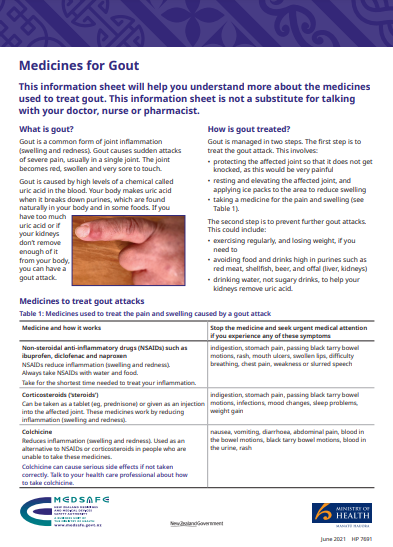Gout attacks are also called flares. They cause severe pain, redness and swelling of 1 or more joints. It usually happens in your big toe but can affect any joint
To manage the pain, rest the affected joint and use ice packs to reduce swelling. There are also medicines that can help to manage the pain and swelling. The choice of medicine depends on other health conditions you may (eg, kidney problems, heart failure, diabetes, stomach ulcers) and other medicines you're taking.
Medicines you may be prescribed are:
Note: If treatment is started straight away, relief from symptoms often occurs within 24 hours. Medicines for pain relief and swelling shouldn't be taken long-term.
Non-steroidal anti-inflammatory drugs (NSAIDs)
NSAIDs include naproxen, diclofenac (Voltaren) and ibuprofen. They can reduce pain, swelling and redness quickly. Use the lowest dose for the shortest time – stop taking them once the pain and swelling has stopped.
- NSAIDs shouldn't be used if you have heart failure, stomach ulcers or kidney problems and if you're taking certain medicines. Read more about when you should not take NSAIDs. Always check with your healthcare provider if NSAIDs are safe for you.
- NSAIDs can cause tummy problems (eg, indigestion and heartburn) so take them with food. Read more about NSAIDs.
- Note: Aspirin is not recommended for pain relief for gout as it can make your symptoms worse. But if you are taking low-dose aspirin for a heart condition, continue taking it. Low dose aspirin doesn't significantly increase your uric acid levels.
Prednisone
- Your doctor may prescribe a short course of prednisone tablets to reduce the pain and swelling.
- Prednisone tablets are usually taken once daily until the attack has settled, then the dose is reduced over 1 to 2 weeks before stopping.
- Take prednisone tablets with food to reduce tummy upset.
- Prednisone tablets are best taken in the morning because they can sleep problems. Read more about prednisone.
Colchicine
- Colchicine is only used if you can't take NSAIDs or prednisone, because it can make you feel sick and cause diarrhoea (runny poo).
- It's important to take the correct dose as there isn’t a big difference between a safe dose of colchicine and a harmful dose. Read more about taking colchicine safely.










